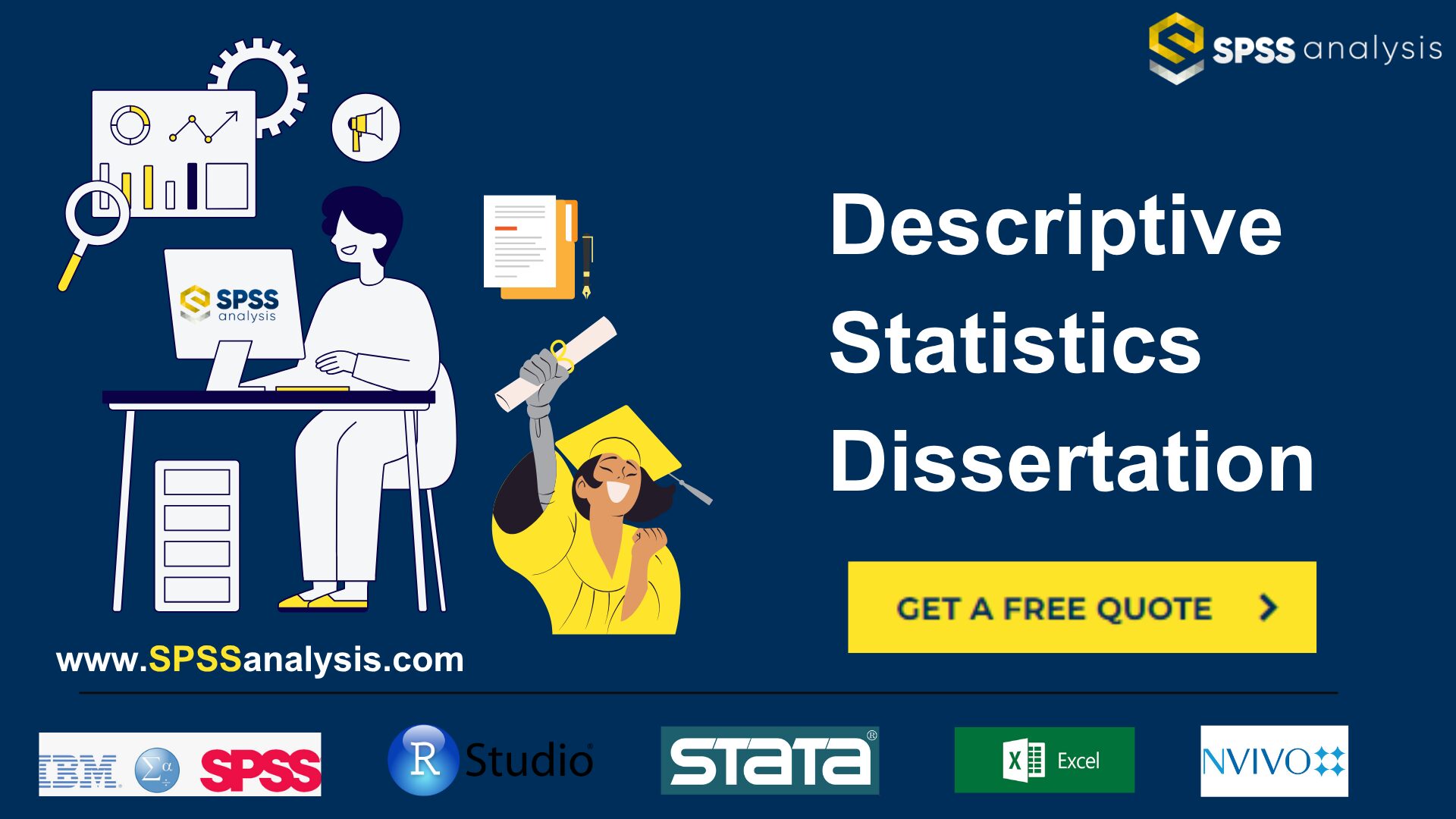Descriptive Statistics Dissertation
Descriptive Statistics Dissertation: Elevate Your Research with Our Customized Data Analysis, Methodology, and Results Writing Services. Specializing in SPSS, R, STATA, JASP, Nvivo, and More for Comprehensive Assistance.
Top-Tier Statisticians 👩🔬 | Free Unlimited Revisions 🔄 | NDA-Protected Service 🛡️ | Plagiarism-Free Work 🎓 | On-Time Delivery 🎯 | 24/7 Support 🕒 | Strict Privacy Assured 🔒 | Satisfaction with Every Data Analysis ✅
Our Expertise Recognized by Students at Leading Universities:




















Dissertation Statistics Support
Statistical data analysis and writing assistance is a comprehensive service tailored to meet the specific needs of your academic research, ensuring that you receive expert support in the following key areas:
- Methodology Writing: We develop a detailed plan for your research approach, outlining the statistical methods to be used in your study. This foundational step ensures that your research is built on a robust methodological framework.
- Data Management: Our services include importing your data into the preferred statistical software, recoding variables to suit analysis requirements, and data cleaning to ensure accuracy and reliability. This process prepares your data for meaningful analysis, setting the stage for insightful findings.
- Data Analysis & Hypothesis Testing: Whether your research requires quantitative data analysis, qualitative data analysis, or a mixed design, our experts are equipped to handle it. We apply appropriate statistical tests for your hypothesis and techniques to analyse your data, uncovering the patterns and insights that support your research objectives.
- Results Writing: We present your findings in a clear and academically rigorous format, adhering to APA, AMA, Harvard, or other academic styles as required. This includes preparing tables and graphs that effectively communicate your results, making them accessible to your intended audience.
Hire a trusted statistician today, and publish with total confidence — Get a Free Quote Now!
How Statistics Support Service Works
Descriptive Statistics for Dissertation: Your Complete Guide to Accurate Reporting and Analysis
When writing a dissertation, your goal is to convince readers that your research is credible, methodologically sound, and worthy of contributing new knowledge to your field. To do that, you must first describe your data clearly and transparently — which is where descriptive statistics come in.
Whether you’re a student in psychology, nursing, education, or business, getting descriptive statistics right is a critical foundation for your entire analysis. Done well, they clarify what your data looks like, highlight trends at a glance, and build trust before you move on to more complex inferential tests.
Yet despite being “basic,” descriptive statistics are where many students lose marks — by choosing inappropriate measures, presenting cluttered tables, or misunderstanding what their summaries really show. This comprehensive guide explains exactly how to use descriptive statistics in your dissertation, common pitfalls to avoid, and how SPSSanalysis.com can help you present your results flawlessly.

✅ Ready to get started? Fill out our form for a Free customised quote, and get help from an expert statistician— stress-free.
What Are Descriptive Statistics — and Why Do They Matter in a Dissertation?
Descriptive statistics are numerical and graphical methods that summarize and simplify your raw data. They don’t test hypotheses — instead, they tell readers what your dataset looks like in clear, digestible terms.
In a dissertation, descriptive statistics serve two main purposes:
- Describe your sample: Who did you study? How many participants? What are their key characteristics (age, gender, education level, income, etc.)?
- Summarize key variables: For each variable of interest, what is the average value? How much variability exists? Are there outliers?
Providing clear summaries helps your supervisor and examiners understand your data before you run deeper analyses.
✅ Ready to get started? Fill out our form for a Free customised quote, and get help from an expert statistician— stress-free.
Common Types of Descriptive Statistics in Dissertations
While specifics vary by discipline, here’s what most dissertations include:
For Categorical Variables (Nominal or Ordinal):
- Frequencies: How many times each category occurs (e.g., number of males vs. females).
- Percentages: Proportion of each category within the sample.
- Mode: The most common category.
For Continuous Variables (Interval or Ratio):
- Measures of Central Tendency: Mean (average), median (middle value), mode (most frequent value).
- Measures of Dispersion: Standard deviation, range, minimum and maximum.
- Shape of Distribution: Skewness and kurtosis, sometimes included for more advanced readers.
Graphical Summaries:
- Bar charts or pie charts for categorical data.
- Histograms or boxplots for continuous data.
At SPSSanalysis.com, we help you choose the right statistics for each variable — no more guesswork or inappropriate charts.
How to Structure Descriptive Statistics in Your Dissertation
A strong results chapter typically starts with a clear description of your sample, followed by summaries of each key variable relevant to your research question.
1. Participant Characteristics (Demographics): Often presented in a single, neat table. Include frequencies and percentages for categorical variables (e.g., gender, ethnicity) and means and standard deviations for continuous variables (e.g., age).
2. Descriptive Statistics for Main Variables: Organize these by research question or hypothesis. For each main variable, present mean, standard deviation, and range at minimum. Where appropriate, include histograms to show distribution.
3. Textual Description: Don’t just drop a table. Always describe the main patterns in words: highlight noteworthy trends, mention any outliers, and note whether distributions are skewed.

This structure shows examiners that you understand your data, not just the software output.
✅ Ready to get started? Fill out our form for a Free customised quote, and get help from an expert statistician— stress-free.
Common Mistakes Students Make With Descriptive Statistics
Despite being straightforward, descriptive statistics are where surprising errors happen:
- Inconsistent reporting: Mixing up percentages and raw counts, or using different decimal places across tables.
- Too much or too little detail: Dumping every possible statistic can overwhelm readers, but omitting key figures leaves gaps.
- Poor formatting: Cluttered tables or unlabeled charts frustrate readers and reduce your dissertation’s professionalism.
- Confusing descriptive and inferential statistics: Sometimes students mistakenly interpret descriptive summaries as evidence for hypotheses — avoid over-claiming!

Getting expert help ensures you strike the right balance.
How SPSS Simplifies Descriptive Statistics — If Used Properly
SPSS makes it easy to generate descriptive statistics: its Frequencies, Descriptives, and Explore commands provide nearly everything you need in seconds. However, many students overlook crucial settings or copy raw output without cleaning it.
With SPSSanalysis.com, we help you:
- Define variables correctly (nominal, ordinal, scale).
- Run appropriate descriptive commands efficiently.
- Format output tables and graphs according to APA or your program’s style guide.
- Cross-check for logical inconsistencies (like impossible values or incorrect coding).
- Interpret output correctly so you write clear narrative explanations.
This saves you hours of confusion and polishes your dissertation’s presentation.
✅ Ready to get started? Fill out our form for a Free customised quote, and get help from an expert statistician— stress-free.
How to Report Descriptive Statistics in APA or AMA Style
Academic style matters. Different fields follow different rules, but some best practices are universal:
For Tables:
- Include a clear title above the table.
- Label all columns (e.g., N, Mean, SD, Minimum, Maximum).
- Use consistent decimal places — typically two.
- Add notes below if needed (e.g., explaining coding of categories).
For Figures:
- Every chart needs a clear caption.
- Axes must be labeled.
- Avoid 3D or flashy effects; simplicity aids clarity.
In Text:
- Introduce each table or figure before showing it.
- Highlight key points: “The mean age of participants was 27.35 years (SD = 5.42).”
- Do not just repeat the entire table in words.
If you’re unsure, our team can provide perfectly formatted tables and even insert them directly into your draft.
✅ Ready to get started? Fill out our form for a Free customised quote, and get help from an expert statistician— stress-free.
Handling Outliers and Missing Data in Descriptive Analysis
Before presenting descriptive statistics, address missing values and outliers honestly.
Missing Data:
- Report how much data is missing for each variable.
- Explain how you handled it (listwise deletion, pairwise deletion, or imputation).
Outliers:
- Use boxplots or the Explore command to detect extreme values.
- Decide whether to keep, adjust, or remove outliers — and justify your choice.
Your supervisor expects you to mention these checks — we help you document them clearly.
How Descriptive Statistics Lead Into Inferential Tests
Remember, descriptive stats are not the final answer — they pave the way for hypothesis testing. For example:
- If your descriptive stats show a large mean difference between groups, an independent t-test may confirm whether it’s statistically significant.
- If distributions appear skewed, you might choose non-parametric tests instead of parametric ones.
Clear descriptive summaries build a solid bridge from raw data to robust conclusions.
✅ Ready to get started? Fill out our form for a Free customised quote, and get help from an expert statistician— stress-free.
Why Get Professional Help With Descriptive Statistics?
Many students think they can handle descriptive statistics alone — until last-minute questions pop up:
- Are my categories coded correctly?
- Why don’t my percentages add up to 100%?
- Should I use mean or median for skewed data?
- How do I explain missing data in my methods chapter?
Expert help means:
- No sloppy tables or confusing charts.
- No second-guessing your choices.
- No nasty surprises during your viva or peer review.
At SPSSanalysis.com, we help you get it right the first time — and explain every step so you stay in control.
Who Uses Our Descriptive Statistics Dissertation Service?
Our clients include:
- Undergraduate students finishing final-year dissertations.
- Master’s students writing thesis chapters under tight deadlines.
- PhD candidates preparing publications based on dissertation data.
- Academic researchers polishing tables for submission to high-impact journals.
Whatever your level, you get personalized support matched to your field and supervisor’s expectations.
✅ Ready to get started? Fill out our form for a Free customised quote, and get help from an expert statistician— stress-free.
How Long Does It Take?
For straightforward descriptive statistics chapters, we typically deliver within 1–4 days. If your dataset is large or you have complex coding issues, it may take slightly longer. We also handle urgent requests — just mention your deadline when you request a free quote.
How to Get Started
Getting professional help is simple:
- Request a Free Quote: Fill out our short form at SPSSanalysis.com with your topic, dataset, and due date.
- Get a Clear Plan: We’ll send you a custom plan and cost within 24 hours.
- Approve and Pay Securely: No hidden fees.
- Relax: We clean your data, run checks, create tables and charts, and explain everything clearly.
- Submit With Confidence: Use our polished outputs directly in your dissertation.
Final Thoughts
Descriptive statistics are the bedrock of trustworthy research. When done correctly, they showcase your dataset clearly and lay the groundwork for rigorous analysis.
Don’t risk careless mistakes or wasted hours wrestling with formatting. Get clear, customized support from real experts who handle SPSS and academic style daily.
Ready to make your dissertation’s descriptive stats shine? Request your free quote today and see how easy clear, professional results can be with SPSSanalysis.com by your side.
Stay connected with SPSSanalysis.com on LinkedIn for the latest updates and insights!





